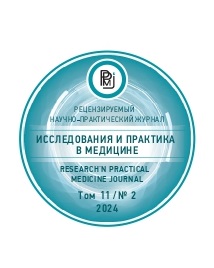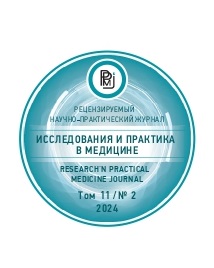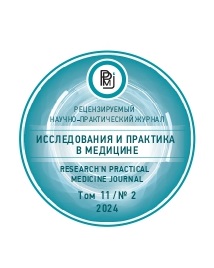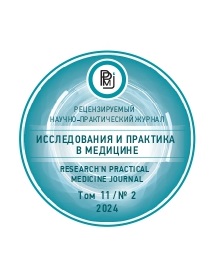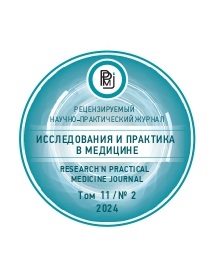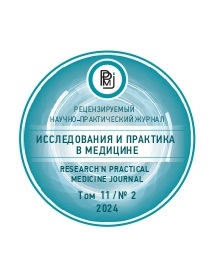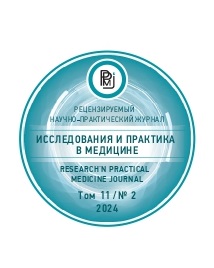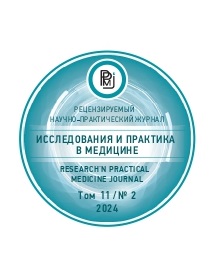Original Articles. Diagnostic radiology
Оne of the most commonly used fluorine‑18 labeled prostate-specific membrane antigen (PSMA) ligands in positron emission tomography combined with computed tomography (PET/CT) is [18F]PSMA‑1007. In comparison to other clinically available PSMA radioligands characterized by renal clearance, [18F]PSMA‑1007 exhibits predominantly hepatobiliary excretion. It allows a better assessment of the pelvic area in patients with prostate cancer (PCa). Nevertheless, in our clinical practice, we routinely observed a notably high [ 18F]PSMA‑1007 uptake in the urinary bladder. The underlying reasons for this phenomenon remain inadequately explored.
Purpose of the study. The purpose of this study was to assess the impact of preliminary hydration of patients on [18F]PSMA‑1007 uptake in the urinary bladder.
Materials and methods. Prospective, multicenter, randomized controlled study included 180 patients with PCa who underwent [18F]PSMA‑1007 PET/CT. Scans were performed using three different PET/CT-systems: GE Discovery IQ Gen 2 (USA), Siemens Biograph 64 mCT and Biograph 64 TruePoint (Germany). All patients were divided into two groups: the group with hydration (n = 95, 53 %), which included the subgroups of patients with oral (n = 76, 80 %) and intravenous (n = 19, 20 %) routes of hydration, and the control group with no hydration (n = 85, 47 %). [18F]PSMA‑1007 uptake in the urinary bladder was quantified using SUVmean (Mean Standardized Uptake value), measured within a spherical VOI with a fixed volume of 2.5 cm3 delineating the bladder boundaries. Additionally, the TBRmean (Mean Target-to-Background Ratio), reflecting the ratio between urinary bladder and right gluteal muscles SUVmean.
Results. SUVmean and TBRmean in urinary bladder were significantly lower (p < 0,001) in the group with hydration compared to the control group, with the following values: 1.3 [0.8; 2.0] versus 4.5 [2.7; 8.5] for SUVmean and 4.0 [2.3; 6.3] versus 13.0 [7.7; 24.0] for TBRmean. There was no significant differences in SUVmean and TBRmean between the subgroups with oral and intravenous routes of hydration (p = 0.95 for SUVmean, p = 0.49 for TBRmean). Additionally, comparatively lower interquartile range (IQR) values for both SUVmean and TBRmean in the group with hydration were noted: 1.2 versus 5.8 for SUVmean, 4.0 versus 16.3 for TBRmean.
Conclusion. Preliminary hydration of patients in uptake period significantly reduces both the level and variability of [18F]PSMA‑1007 uptake in the urinary bladder.
Original articles. Oncology, radiotherapy
Purpose of the study. To study the intensity of lipid peroxidation (LPO) and the activity of antioxidant protection components in tumor tissues, peritumoral zone and conditionally healthy skin tissue in basal cell carcinoma, depending on the type of tumor growth, gender of patients, and the presence of concomitant diseases.
Materials and methods. Tissues from 34 patients with basal cell carcinoma (BCC) were studied, including 17 women (10 with superficial tumor growth and 7 with solid growth) and 17 men (5 and 12 patients, respectively). We used skin flaps obtained during operations on 12 men and 10 women without malignant pathology (“norm”) as a comparison material. The content of malondialdehyde (MDA), diene conjugates (DC), superoxide dismutase (SOD) activity and total peroxidase activity (TPA) were determined. Statistical processing of the results was carried out using the Statistica 10.0 program.
Results. In women, the level of MDA was increased in all tissues: with superficial growth of BCC by 2.1–2.5 times (p ≤ 0.05), with solid growth by 1.6–2.1 times (p < 0.05) relative to the “norm”. In men with superficial growth, an MDA increase by 3.2 and 3.1 times in tumor tissue and conditionally healthy tissue was observed (p < 0.02), and no increase in MDA in the tumor was detected in 11 of 12 patients with solid growth. An increase in DC (on average 2–5 times) in BCC patients with concomitant hypertension and diabetes mellitus was observed mainly in women. Activation of SOD in tumor tissue, to a greater extent in men (2.4 times with superficial growth and 1.7 times with solid growth, p < 0.05 relative to conditionally healthy tissue), can be considered as a mechanism of antiradical protection of the tumor.
Conclusions. An increase in the level of MDA in BCC was observed in tumor and nearby tissues in women with both types of growth, in men only with superficial growth. Analysis of individual characteristics of LPO indicators in patients with skin carcinoma revealed a dependence of the severity of the increase in MDA and especially DC on the presence of concomitant pathology (hypertension, diabetes mellitus).
Against the background of modest successes in the development of new diagnostic and therapeutic tools to improve the survival of patients with glial brain tumors, early diagnosis of this pathology remains relevant. Endogenous noncoding miRNAs that regulate the expression of target mRNAs have become attractive targets for the development of circulating biomarker-based assays, because sample acquisition does not require invasive sampling such as biopsy.
Purpose of the study. To determine the levels of circulating microRNAs in the blood plasma of patients with glial tumors, meningiomas and apparently healthy donors, using high-output sequencing.
Material and methods. 26 blood plasma samples were selected from the biobank data base of the National Medical Research Center for Oncology, and the total RNA was studied using the NGS sequencing method. The sample included: 2 cases of oligodendroglioma (grades 2–3), 6 – astrocytomas of 2–4 degrees of malignancy, 7 – glioblastomas of 4 degrees of malignancy, 7 – benign neoplasms (meningiomas), 4 – control (conditionally healthy donors).
Results. During the primary analysis, a pool of 71 differentially expressed microRNAs was identified, the expression of which was tumor-specific: 20 microRNAs for glioblastoma, 4 microRNAs for astrocytoma, 23 microRNAs for oligodendroglioma, 24 microRNAs for meningioma. At the same time, 47 microRNAs showed increased levels in the blood plasma compared to the control group, 15 showed a corresponding decrease in levels. A comparative analysis identified microRNAs that specifically differentiate each tumor type.
Conclusion. The results obtained seem promising and set the vector for further research, which will include expanding the sample and validating the identified biomarkers to determine their diagnostic value.
Purpose of the study. To determine the thyroid status of primary cancer patients in the early stages of uterine body cancer, kidney cancer, breast cancer, skin melanoma and lung cancer without a history of endocrine pathology.
Patients and methods. The content levels of thyroid-stimulating hormone (TSH), thyroid hormones (THs) T4 and T3 of total and free forms were determined in the blood serum by RIA method in 132 patients with breast cancer, uterine body cancer, lung cancer, kidney cancer and skin melanoma (average age 55 years). The comparison group consisted of practically healthy donors.
Results. Only in skin melanoma, serum TSH levels were reduced by 1.5 times (p < 0.05). The T4 content was reduced by 1.4–1.7 times (p < 0.05) in uterine body cancer and kidney cancer, increased in lung cancer patients and 16 % of breast cancer patients by 1.4–1.7 times though (p < 0.05). A 1.3–1.5‑fold low (p < 0.05) T3 level was found in breast cancer, kidney cancer, and skin melanoma, while an 1.6‑fold increase (p < 0.05) was found in uterine body cancer. The revealed changes in THs by the type of clinical hyperthyroidism are an increase of 1.8 times (p < 0.05) FT3 on the background of low TSH in the blood in patients with skin melanoma, and by the type of hyperthyroxinemia in patients with lung cancer and breast cancer, consisting in increased concentrations of T4 and FT3, and with free and total T3 levels in patients uterine body cancer, as well as FT4, without changes in TSH in the blood serum of patients, may be associated with the features of malignant pathology, since it is known that THs are proliferation stimulants and can build up in tumors.
Conclusion. The development of a malignant tumor even in the early stages of the disease is perceived by the body as a threat for homeostasis and the response to the occurrence of neoplasm is the reaction of the hypothalamicpituitary-thyroid regulatory axis. As an outcome, patients develop euthyroid disorder syndrome.
Experience exchange
Automatic ultrasound examination of the breast (3D ultrasound) has become an important tool in the diagnosis of breast cancer. It is believed that 3D ultrasound has high reproducibility, low dependence on the operator, less time spent on obtaining images, and automatic three-dimensional reconstruction of the entire breast.
Purpose of the study. To develop indications for 3D ultrasound based on predictive screening models for patients with a low risk of developing breast tumors based on the identification of the most significant risk factors.
Patients and methods. A retro-prospective clinical study has been conducted from February 2019 to May 2023. A total of 2794 patients were included in the study. All patients underwent clinical examination, palpation, collected information on socio-demographic data and potential risk factors for breast cancer, and 2D ultrasound was also performed. The group under the age of 40 included 1,511 patients, of whom 628 underwent 3D ultrasound. The sample of 40 years and older included 1,283 patients, 655 of whom underwent 3D ultrasound. Mammography was performed in patients aged 40 and older. Quantitative and qualitative indicators of anamnesis and clinical examination, as well as MMH results in patients over 40 years old, were recorded. Based on these data, a logistic regression was compiled, followed by the selection of the most significant model by cutting off insignificant factors according to the p-level of significance and presenting the model as a ROC curve.
Results. The most significant risk factors for the detection of breast cancer were identified. Based on their screening with 3D ultrasound in a group up to 40 years of age, it can be used in 95.96 % and is not indicated in 4.04 %. The presented model in the group up to 40 years worked correctly in 99.21 %. While screening with 3D ultrasound in a group of 40 years and older in 84.26 % is appropriate and not indicated in 15.74 %. The presented model worked correctly in 97.12 %.
Conclusion. The study identified important pre-diagnostic factors for the choice of a diagnostic algorithm for breast examination in women of different age groups, and determined the indications for 3D ultrasound. The developed algorithms will help optimize screening and referral for additional examinations, which is of practical importance for improving diagnostics and optimizing healthcare resources.
The development of new local treatment methods of peritoneal carcinomatosis in ovarian cancer is an urgent task due to the fact that in most cases complete surgical cytoreduction is technically impossible, and systemic cytostatic therapy does not provide a stable therapeutic effect. The pressurized intraperitoneal aerosolized chemotherapy (PIPAC) is a local method of treating peritoneal carcinomatosis in ovarian cancer, which allows for uniform distribution of medicinal aerosol over the peritoneum and is used together with standard combined treatment in order to improve its outcomes.
Purpose of the study. To analyze the effect of PIPAC, used in addition to the standard combined treatment of ovarian cancer with peritoneal carcinomatosis, on the clinical outcome of surgical treatment and long-term results.
Patients and methods. Our prospective randomized open-label controlled trial included 169 patients with newly diagnosed ovarian cancer with peritoneal carcinomatosis. The main group included 84 patients and 85 in the control group. Randomization was performed intraoperatively using a digital randomizer. The distribution was homogeneous according to the stages of ovarian cancer (Barnard's criterion = 0.292) and the peritoneal carcinomatosis index (PCI) (Mann-Whitney U test = 0.625). We used a combination of surgical cytoreduction with a one-time PIPAC session and subsequent systemic chemotherapy within the framework of one hospitalization, further PIPAC sessions were performed 2 more times with an interval of 42 days in combination with systemic chemotherapy within the framework of one hospitalization. All patients were operated on at the first stage in the volume of extirpation of the uterus with appendages and removal of the large omentum, all underwent systemic cytotoxic therapy scheme: paclitaxeln 175 mg/m2 , carboplatin AUC 5–7) (6 courses with an interval of 21 days). In the main group, 3 sessions of PIPAC were added to the standard treatment. To study the surgical safety profile of PIPAC, all adverse events of a surgical profile were recorded at each hospitalization. The duration of life without relapse was estimated as the main outcome, the median relapse-free survival was the main indicator. The total duration of the study was 36 months.
Results. During statistical processing, it was found that the median disease-free survival in the group with the use of PIPAC was 8 months higher. Thus, in the control group, the median disease-free survival was 13 months in the 95 % confidence interval (in the range of values from 12 to 14 months), in the main group – 21 months (95 % confidence interval, range from 18 to 22 months). Surgical adverse events were reported in 1.2 % after 252 sessions of PIPAC over the entire study period. These phenomena didn’t require additional medical interventions, didn’t increase the duration of hospitalization and didn’t lead to the exclusion of patients from the clinical trial protocol.
Conclusion. The use of the PIPAC technique as an additional method of standard regional treatment has demonstrated an improvement in the results of treatment of newly diagnosed ovarian cancer with peritoneal carcinomatosis. PIPAC has a favorable surgical safety profile and is a promising method of local exposure to peritoneal carcinomatosis in both clinical and research work.
Review
Purpose of the study. To evaluate the role and possibilities of various types of immunotherapy in the treatment of skin melanoma, as well as the prospects for its use in clinical practice.
Materials and methods. The literature was looked up in the PubMed database. Publication date limit was set from 2018 to 2023. The following keywords were used as search queries: "Melanoma", "Melanoma and immunotherapy", "Treatment of Metastatic Melanoma", "Immunological Factors". Full-text versions were selected. Articles that were based on the subjective opinion of the authors were excluded from the study. For each research found, the following parameters were recorded: treatment method, number of patients, follow-up period, time of relapse-free course, survival rate. No meta-analysis of the data was performed due to the high heterogeneity of the studies.
Results. A sufficiently high efficiency of adjuvant therapy with inhibitors of immune response control points in the treatment of BRAF-negative patients has been noted. For this reason, the drug ipilimumab, which appeared among the first, demonstrated its effectiveness. The drug nivolumab gave, according to one of the studies, a 5‑year overall survival rate of 35 %. The use of pembrolizumab was associated with a 5‑year overall survival rate of 41 %. In the 2015 meta-analysis It has been demonstrated that the use of nivolumab, as well as pembrolizumab, provides the best overall survival, and therefore can be included in first-line therapy. The combination of these drugs makes it possible to achieve a good response to therapy in patients with BRAF-positive status (5‑year overall survival rate of 52 %).
Conclusion. Melanoma immunotherapy with immune response checkpoint inhibitors is currently the most effective treatment method, especially in cases where it complements surgical resection of the tumor. The most commonly used drugs are nivolumab and ipilimumab, which work more effectively when combined. Thus, the 5‑year progression-free survival rate is 36 %, the overall survival rate is 52 %. Resistance to immunotherapy is an important problem of this type of treatment, the solution of which will help to improve the outcomes of control over the local cancer process and improve the response to therapy. It is possible to find a solution to this problem due to the fundamental study of the molecular biology of the tumor in terms of modeling tumor growth and tumor "escape" mechanisms.
Clinical Case Reports
Primary multiple malignancies (PMMs) are defined as two or more malignant tumors of various pathogenic origin detected simultaneously or sequentially in one patient. Despite the successes of modern medicine, the incidence of PMMs is steadily increasing. According to worldwide statistics, the incidence of PMMs in the oncological population has increased from 2.4 to 8.0 % over the course of the 20 year span. The number of patients with PMMs is also increasing in the Russian Federation. Total of 58,217 PMMs were detected for the first time in our country in 2021, which constitutes 10.0 % of all newly diagnosed malignant neoplasms. Two tumors are usually observed among patients with PMMs (in 84–100 % of patients), three tumors occur in 9.9–16.0 % of these patients, four in 1.62 %, and five or more occur in only 0.095 %.
Currently, the pathogenesis of this condition has not yet been fully studied. There are hypotheses that endogenous, exogenous, hereditary, and therapeutic factors are involved in the occurrence of PMMs. Endogenous factors include immunologic status, endocrine factors, and hereditary predisposition. Exogenous factors are represented by lifestyle and environmental factors such as smoking and alcohol, low physical activity, as well as prolonged exposure to ultraviolet radiation and industrial pollution. Iatrogenic factors, including radiation therapy and chemotherapy, can also increase the risk of developing PMMs.
This article represents a clinical case of a patient born in 1942, in whom, during 11 years of follow-up care, primary multiple synchronous metachronous cancers of 5 localizations and 4 histological types were verified and treated. The presented clinical case is interesting for a very rare number of neoplasms and a relatively high duration of follow-up period. The authors describe in detail each stage, the choice of diagnostic methods and the definition of treatment tactics with an assessment of the accuracy of clinical decision-making.



